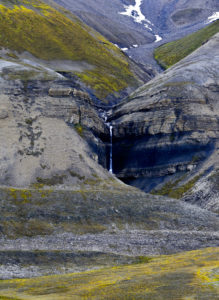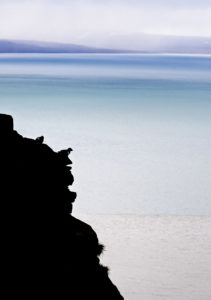Realizing goals
We are still here – no worries, not in Pyramiden! Me and Pekka stayed here for an additional 17 days to conduct field research related to our earlier work. I am happy to say that so far, we have implemented few new things we learned during the course.
My very first notice was that I do my work in more detail than before. My background is in physical geography, and I tend to look for the more general patterns or common trends instead of focusing on every detail I come across. Two weeks before the course I was doing the exact same work in Greenland, and I did it a lot faster than after our course, and the reason is that I take more time to do everything (just as every ecologist I have ever met – always caught on the details!). Paying more attention to details is something I value, yet, I felt a bit anxious when I realized that details are not what will get us through all 960 study plots before leaving Svalbard…
More interesting than me being slow is that we were really impressed by the work that the leaf temperature group did. On the last course day, we talked with Sean about doing some thermal imaging as part of our research and just few days ago we carried out this latest addition to our data! We burrowed the Flir camera from Pernille and did three imaging campaigns on a subset of our plots (n = 120). Each of those intensively studied plots are now immortalized in three different lighting conditions (12 AM; 6 PM; 12 PM). I am so excited about this new approach we have taken! I see a collaboration somewhere in the near future – maybe my first publication in relation to plant traits?
About collaborating – we set up our study sites within the areas that the remote sensing group flew over with the drone (droned – that should be a word!). For finding each of our plots within the areas, we are using the same differential GPS device as the we used on the course, so we can find our plots from the remotely sensed images. Based on the digital elevation model derived from those images, we can calculate very high resolution topography parameters, such as wetness index, topographic position and radiation – all relevant for our study subjects: plants.
In addition to vascular plants, I truly enjoyed learning about mosses as well. I have worked side by side with bryophyte experts for the past six summers, but our field work season is always so intense that I have not found the time focus on mosses – until now. The other traits day (OTD) was highly interesting for me, since I have always considered mosses to be extra tricky to identify out in the field. Yet, I managed to help in the sampling and learnt couple of new species from a totally new group! Today I had another moss day, OTD – the sequel, as I helped Pekka to sample some Aulacomnium, Hylocomnium and Tomentypnum, while he was collecting moss community data on the PFTC4 plots. Despite knowing three moss species, I still feel that my strength lies in vascular plant identification, so I decided to implement my newly found fondness of details and go through all the Draba sp. on our plots and give them names!
This gets us finally to my goals: 1) get a proper hang of plant functional traits; and 2) submit. I have met the first one to the extent that I am already implementing some of the things I learnt on the course. The latter is a much longer process, but it is in motion: the data are now collected.
Learning something new about me
Besides finding the slow and detail-oriented side of myself, I have grown a lot during this whole summer. Next week I will return to Helsinki after being 11 weeks on the road and I feel that I have grown as a researcher mor e than ever (or since I am only at my second PhD year, maybe my growth has just now begun?). I cannot really pinpoint what has changed in me, but I feel like I know my field and my skills better than ever. Besides our lab, this course was the first event where I have felt like at home scientifically – everyone seemed to be speaking the same language. I get overwhelmed when I think about the amount of expertise and drive (and data) that was present – was this “only” a course? The top-quality morning lectures made the course feel more like a two-week-mini-conference with really awesome excursions. Every lecture, presentation and conversation taught me something new, and I noticed myself constantly looking for an angle to connect any topic with my own research “How can I link this to plant-moisture relationships? What is the relation of this species/habitat/phenomenon to water conditions?”. But most of all, I learnt that I am good at something, or at many things in fact, and that people are interested in the research I am doing, and all this together is really encouraging.
e than ever (or since I am only at my second PhD year, maybe my growth has just now begun?). I cannot really pinpoint what has changed in me, but I feel like I know my field and my skills better than ever. Besides our lab, this course was the first event where I have felt like at home scientifically – everyone seemed to be speaking the same language. I get overwhelmed when I think about the amount of expertise and drive (and data) that was present – was this “only” a course? The top-quality morning lectures made the course feel more like a two-week-mini-conference with really awesome excursions. Every lecture, presentation and conversation taught me something new, and I noticed myself constantly looking for an angle to connect any topic with my own research “How can I link this to plant-moisture relationships? What is the relation of this species/habitat/phenomenon to water conditions?”. But most of all, I learnt that I am good at something, or at many things in fact, and that people are interested in the research I am doing, and all this together is really encouraging.
Hot topic
I enjoyed seeing the results of our survey regarding climate change perceptions of Svalbardians. Going through the results immediately after collecting the data was eye-opening and rewarding too. I am really looking forward to reading the upcoming article on this! If we would conduct a similar survey in Helsinki, the results would probably be somewhat similar – people would say they know everything about global warming, and yet they would say they fight it by avoiding plastic. Plastic pollution is simple (not to mention trendy too): refuse, reuse and recycle. Anthropogenic climate change in this modern world we live in is very challenging. How can people fight it if they live in the high-Arctic on an island run by coal, where everything is brought here by air freight, and every now and then they need to fly to the mainland to see their relatives, supervisors or dentists? Climate change is a big controversial burden, whereas demonizing plastic is something that everyone can stand for and fight for in their everyday choices.
Social media:


